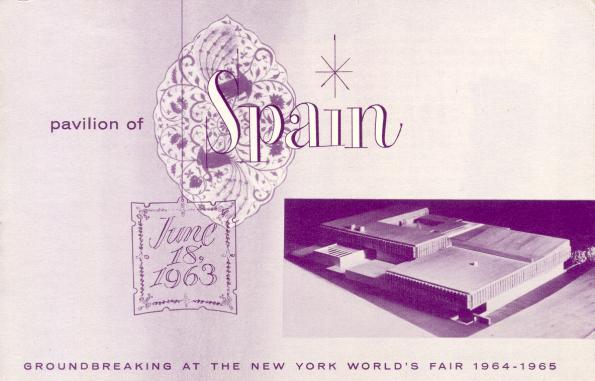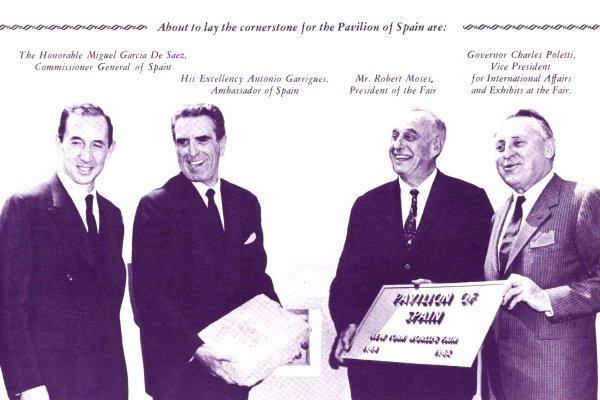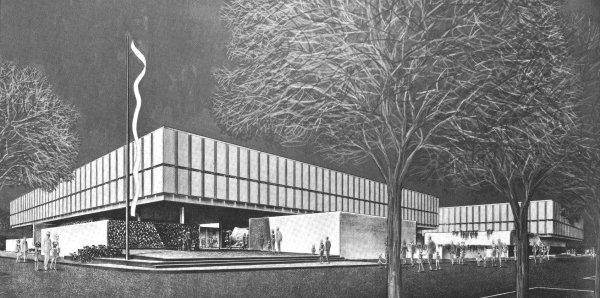 |
The
dominant theme of the Pavilion of Spain will be Spain's influence
in the discovery, colonization and independence of America. The
pavilion will feature art galleries, fashion shows, concerts,
three restaurants and a wine cave. Francisco Javier Caravajal
Ferrer of Madrid is the architect and Kelly and Gruzen of New
York are consulting architects.
|
SOURCE: Groundbreaking
Brochure, The Pavilion of Spain
|
Excerpts from
transcription of remarks made by Spanish and World's Fair officials
at the groundbreaking ceremonies for the Pavilion of Spain, New
York World's Fair. Tuesday, June 18, 1963.
DR. ROBERTO DE
MENDOZA [Deputy Chief of Protocol]: Excellencies, Mr. Commissioner
General, Mr. Moses, Governor Poletti, distinguished guests, ladies
and gentlemen. We are here this morning for a very important
ceremony -- the laying of the cornerstone for the Pavilion of
Spain. This pavilion will bring to Flushing Meadow the essence
of Spain -- its history and culture, its achievements and aspirations,
its art and folklore, the beauty and fascination of its great
cities, resorts, hamlets and countryside, and above all, the
happy, gay, stalwart spirit of its people.
The first speaker
has recently returned with happy memories of Spain, which he
loves and has visited often. it is my pleasure to present Governor
Poletti, vice president of International Affairs and Exhibits
for the New York World's Fair.
GOVERNOR CHARLES
POLETTI: Mr. Ambassador, friends. We're getting together for
what we believe is a significant purpose: to expand the friendship
that we of the World's Fair have formed with the Ambassador,
the Commissioner General, the Consul General and all the officials
of the Government of Spain ... to expand that friendship into
the hearts of millions of Americans. We think it important that
the American people, especially the new generations, learn of
the great and unique contributions that Spain has made through
the centuries, contributions to the civilization of Europe, to
our own, to the Far East, to the whole world. We trust that this
pavilion, which will be a handsome and attractive and big one,
will give the American people a deeper appreciation of the tremendous
contributions made in the past by Spain, and an admiration for
its people; and more than that, an appreciation of what Span
has achieved in the past two decades. Spain has had a stable
government, a solid government, a government that has shown great
progress, and we Americans are happy to be associated with the
people of Spain, not only in this World's Fair, but to be associated
with them in achieving our common desires: justice and peace
and friendship throughout the world.
I thank you all
for coming here and I know that we're going to have a very successful
Pavilion of Spain. I'm delighted to join you all. Thank you.
DR. DE MENDOZA:
Thank you, Governor Poletti. Our next speaker seems to be an
extremely young man to have had such a very active and varied
career. A member of the Spanish Parliament during the last nine
years, he has lectured on international affairs in the Middle
and Far East. He is president and cofounder of the International
Press Club of Spain. He has headed various Spanish economic and
industrial missions to foreign countries. He has twice been a
member of the Spanish delegation to the United Nations and was
Commissioner General for the Pavilion of Spain at the Brussels
World's Fair in 1958. I have the pleasure to present The Honorable
Miguel Garcia De Saez, Commissioner General for the Pavilion
of Spain at the New York World's Fair.
THE HONORABLE
MIGUEL GARCIA DE SAEZ, COMMISSIONER GENERAL OF SPAIN: It is a
real pleasure for me to be here today at the cornerstone laying
ceremony for our Spanish Pavilion. I would say that it is more
than a pleasure -- it is a proud feeling of a man who has been
given the opportunity to devote all his activities, his full
energy and his enthusiasm to a worthy cause.
Spain could not
have missed the World's Fair. We could not miss it for two important
reasons. The first reason is of a sentimental nature. America
is the heart of Spain. The feeling is not new, it comes from
the days when Spain had a queen named Isabella, who sold her
jewels, who pledge her own property in order that a new world
be discovered. Thanks to this queen, in 1492 three small Spanish
ships bringing wealth and civilization and culture landed in
this wonderful hemisphere. Since then we have always viewed with
joy every great American achievement which serves as an additional
proof of the magnitude of its people.
This Fair is
one more of these achievements -- for this one something connected
with 1492 had to come to these Fairgrounds. I could not think
of anything better than to bring from Spain to this pavilion
an historical stone, part of the colossal monument where the
glorious queen is resting.
The second reason
is even more important. Everyone knows how deeply emotions are
rooted in our Latin hearts. In spite of this I say that the second
of our reasons to attend this Fair is more important than the
first and it is so because of the impact that the Fair will have
on mankind. We could not resist the purpose of the Fair: Peace
through Understanding. I congratulate the leaders of the Fair
who have laid down such an inspiring program. When we think of
the seventy million visitors viewing the most outstanding developments
in every field and epoch of the nations of the world, we are
deeply impressed by the admirable progress that will be made
along the road of understanding and, perforce, of peace.
We are here today
for something more than the mere laying of a cornerstone for
a new pavilion in new Fair. Our ceremony is more significant
than this. We are here to pledge our support to the leaders of
the New York World's Fair and to assure them that the Pavilion
of Spain enthusiastically adheres to its purpose and will be
devoted to the great cause of promoting understanding among the
peoples of the world, especially between these two great peoples,
the Spaniards and the Americans. Thank you.
|
 |
|
DR. DE MENDOZA:
Thank you, Senor Garcia De Saez. Our next speaker also recently
returned from Spain with very happy memories. I give you The
Honorable Robert Moses, president of the New York World's Fair
Corporation.
MR. ROBERT MOSES:
Ambassador Garrigues, Commissioner General De Saez, friends.
The Government of Spain has placed in the hands of exceptionally
able, attractive and enthusiastic representatives the task of
planning, building and equipping of a pavilion of surpassing
ingenuity, with superb evidences of Spanish genius, culture and
enterprise. You speak for a civilization which has placed its
seal indelibly upon half the people of this continent. Here at
Flushing Meadow you embrace an opportunity to impress the image
of the new Spain upon the whole world. Here you will make a profound
impression of what is at once an old and a new Iberian civilization.
We extend to you from the Fair the sincere hand of friendship
and our pledge of fullest cooperation.
DR. DE MENDOZA:
Thank you, Mr. Moses. Before presenting our next speaker I should
like to introduce some prominent and very distinguished Spanish
visitors who are honoring us with their presence today. First,
the architect for the Pavilion of Spain, Senor Francisco Javier
Carvajal Ferrer; Senor Manuel Ortuno, executive director of the
Pavilion of Spain; Senor Joaquin Gutierrez Cano, a director of
the World Bank; Senor Fernando Escribano, Commercial Attache
of the Spanish Embassy; el Excelentisimo Senor Jaime de Pinies,
Deputy Permanent Representative and Charge d' Affaires ad interim
to the United Nations; el Excelentisimo Senor Angel Sanz-Briz,
Consul General of Sapin; Senor Rafael Heredia, engineer.
Our next speaker
is a very distinguished diplomat and renowned attorney. He is
former Assistant Attorney General and during World War II was
legal advisor to the Allied Purchasing Commission in Spain. As
a specialist in international finance he has represented very
important foreign banking and investment firms in Spain. He has
taken a very active and decisive part in negotiations between
Spain and the Export-Import Bank, the International Finance Corporation
and the Agency for International Development.
At the same time
he has found time to become a very well-known author and has
written many books and articles, published in Spain and abroad,
on legal, economic, political and financial subjects. It is my
high honor to introduce the Ambassador of Spain, His Excellency
Antonio Garrigues.
|
 |
|
HIS EXCELLENCY
ANTONIO GARRIGUES, AMBASSADOR OF SPAIN: President Moses, Governor
Poletti, distinguished guests and ladies and gentlemen. It is
for me a great occasion and a great honor to be here today with
so distinguished a gathering and I thank each of you most sincerely
for being here. It is a most important occasion for Spain, and
your very presence reminds us of our tremendous responsibility
in this Fair.
I want to express
and emphasize, on this occasion, the great friendship between
our two countries. We Spaniards are proud of this friendship
and we ask that God grant it will always remain and that both
countries will always strive for the same goals -- to defend
our civilization, to defend our freedom, to defend the values
in which both countries so deeply believe.
I know that you
look forward to a great Pavilion of Spain where a true representation
of the very essence of our country is to be displayed. You are
expecting to see and hear those things for which we are best
known: our works of art, dances which have been handed down from
generation to generation and our vibrant music. These are the
words of the universal language that the people of all nations
understand, and that contribute strongly to a feeling of friendship
among countries.
I am sure that
you are interested not only in our great past, but also in our
present achievements in the fields of economics, agriculture,
industry, commerce, social security and all the equally important
sectors which will be on exhibit to show how Spain is keeping
pace with the modern world. This is what you expect to see and
I can assure you that you will not be disappointed.
It is a comforting
thing to know that with this great task before us, we have the
magnificent cooperation of Mr. Moses, the Fair's president, of
Governor Poletti and of every member of the Fair Corporation.
The New York World's Fair presents an excellent opportunity to
work towards peace and good will among men and nations. Here,
through these exhibits, each country can express its most salient
characteristics and make them known to the millions of visitors
who will view them. We pledge ourselves to do our utmost to make
this Fair a success in every sense of the world. Thank you.
DR. DE MENDOZA:
Thank you, Mr. Ambassador. Ladies and gentlemen, the Ambassador
of Spain and Mr. Moses will now lay the cornerstone for the Pavilion
of Spain.
|
SOURCE: Portland
Cement Association Booklet: Concrete at the Fair
|
|

|
|
|
|
- Pavilion of Spain
-
-
-
ARCHITECT:
|
- JAVIER CARVAJAL, CONSULTING
ARCHITECTS: KELLY & GRUZEN
|
-
ENGINEER:
|
- LEV ZETLIN ASSOCIATES, PRECAST
PANELS BY PLASTICRETE CORPORATION
|
- The precise geometry of the
Spanish Pavilion is reminiscent of the early international style
of architecture which found great favor with architects on the
continent. The pavilion's appearance is enhanced by the projecting
pre-cast wall panels which completely enclose the main structure.
Some of the exposed-aggregate panels are simple flat rectangles,
four feet wide and seven to nine feet high.
-
- The striking shape and scale
of the main structural wall units, with their clean shape arises
and uniform surface texture, provide a nicely-balanced contrast
to the lower walls and interior partitions. Most of the latter
are concrete or concrete masonry, and all are covered with portland
cement stucco finished in the uneven surface typical of the Spanish
style. Inside and out, the Pavilion of Spain will be a delight
to see and a treat to visit this summer.
|
|
|
 |
|
|